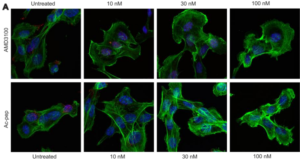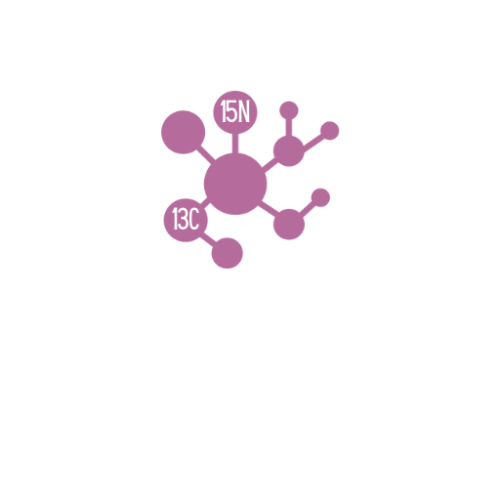
SDF1 (CXCL12) labelled 15N for Mass Spectometry and NMR, LPS-Free
SDF-1α for Mass Spectrometry is the 8 kDa protein uniformly labelled with isotope 15N.
This protein is suitable for Mass Spectrometry and NMR studies.
This product corresponds to the human sequence and is produced in E.coli using a media in which the only source of nitrogen come from 15NH4Cl.
SDF-1α we provide is the natural protein, with no tags or additional amino acids.
It has the sequence:
[“MKPVSLSYRCPCRFFESHVARANVKHLKILNTPNCALQIVARLKNNNRQVCIDPKLKWIQEYLEKALNK”]
Molecular Mass: Stromal Cell-Derived Factor 1α (SDF-1α, CXCL12) consists of 69 amino acid residues and has a calculated molecular mass of approximately 8 kDA
Purity: The purified protein is >95% homogeneous (electrophoresis and mass spectrometry). It contains no nucleic acids.
Endotoxin Level: The purified protein is free from LPS (Pierce™ Chromogenic Endotoxin Quant Kit, <0.1 EU/mL). The product contains <0.006% v/v of Triton X-114 due to LPS removal procedure. The remaining traces of Triton X-114 can be removed upon request.
Buffer: Stromal Cell-Derived Factor 1α (SDF-1α, CXCL12) is lyophilized from DPBS without Ca and Mg.
Storage: 2-8°C when lyophilized. The protein once reconstituted with water can be stored frozen (-20°C). Avoid repeated freezing and thawing.
This product is intended for research only, and cannot be used on humans.
Publications:
- An 8-Hydroxy-Quinoline Derivative Protects Against Lipopolysaccharide-Induced Lethality in Endotoxemia by Inhibiting HMGB1-Mediated Caspase-11 Signaling
- Lipopolysaccharide-Activated Canine Platelets Upregulate High Mobility Group Box-1 via Toll-Like Receptor 4
- A RAGE-antagonist peptide potentiates polymeric micelle-mediated intracellular delivery of plasmid DNA for acute lung injury gene therapy
- The Time-Course of Antioxidant Irisin Activity: Role of the Nrf2/HO-1/HMGB1 Axis
- Lipopolysaccharide-regulated secretion of soluble and vesicle-based proteins from a panel of colorectal cancer cell lines
- High-mobility group box protein-1 induces acute pancreatitis through activation of neutrophil extracellular trap and subsequent production of IL-1β
- Increased cell-free fetal DNA release after apoptosis and sterile inflammation in human trophoblast cells
- Photodynamic Therapy in Combination with the Hepatitis B Core Virus-like Particles (HBc VLPs) to Prime Anticancer Immunity for Colorectal Cancer Treatment
- The protective mechanism of salidroside modulating miR-199a-5p/TNFAIP8L2 on lipopolysaccharide-induced MLE-12 cells
- Inhibition of inflammatory liver injury by the HMGB1-A box through HMGB1/TLR-4/NF-κB signaling in an acute liver failure mouse model
- CXCL12 promotes the crossing of retinal ganglion cell axons at the optic chiasm
- Ultrasound-targeted microbubble destruction promotes PDGF-primed bone mesenchymal stem cell transplantation for myocardial protection in acute Myocardial Infarction in rats
- Biodegradable nano black phosphorus based SDF1-α delivery system ameliorates Erectile Dysfunction in a cavernous nerve injury rat model by recruiting endogenous stem/progenitor cells
- Methazolamide Reduces the AQP5 mRNA Expression and Immune Cell Migration-A New Potential Drug in Sepsis Therapy?
- Correlations of Serum Retinol-Binding Protein and Stromal Cell-Derived Factor-1 with Renal Function in Patients with Diabetic Kidney Disease
- RNA Analysis of Circulating Leukocytes in Patients with Alzheimer’s Disease
- Suggested mechanism of CCR5Δ32, CCR2-64I and SDF 1-3’A allele frequency change in Polish and Lithuanian gene pools from the perspective of passing time
- Molecular and Brain Volume Changes Following Aerobic Exercise, Cognitive and Combined Training in Physically Inactive Healthy Late-Middle-Aged Adults: The Projecte Moviment Randomized Controlled Trial
- Secondary damage and neuroinflammation in the spinal dorsal horn mediate post-thalamic hemorrhagic stroke pain hypersensitivity: SDF1-CXCR4 signaling mediation
- SDF1-CXCR4 Signaling Maintains Central Post-Stroke Pain through Mediation of Glial-Neuronal Interactions
- Autocrine regulation of tumor cell repopulation by Hsp70-HMGB1 alarmin complex
- Cisplatin Dependent Secretion of Immunomodulatory High Mobility Group Box 1 (HMGB1) Protein from Lung Cancer Cells
- Redox-sensitive high-mobility group box-1 isoforms contribute to liver fibrosis progression and resolution in mice
- Identification of protein biomarkers for prediction of response to platinum-based treatment regimens in patients with non-small cell lung cancer
- Shenshuaifu Granule Attenuates Acute Kidney Injury by Inhibiting Ferroptosis Mediated by p53/SLC7A11/GPX4 Pathway
- S-nitrosylation attenuates pregnane X receptor hyperactivity and acetaminophen-induced liver injury
- Citrullinated isomer of myelin basic protein can induce inflammatory responses in astrocytes
- IL-17A Enhances Microglial Response to OGD by Regulating p53 and PI3K/Akt Pathways with Involvement of ROS/HMGB1
- HMGB1 cleavage by complement C1s and its potent anti-inflammatory product
- Cleavage of HMGB1 by Proteolytic Enzymes Associated with Inflammatory Conditions
- The importance of the CXCL12/CXCR4 axis in therapeutic approaches to Diabetes mellitus attenuation
- Peroxynitrite Exposure of CXCL12 Impairs Monocyte, Lymphocyte and Endothelial Cell Chemotaxis, Lymphocyte Extravasation in vivo and Anti-HIV-1 Activity
- Upregulation of C-X-C motif chemokine 12 in the spinal cord alleviated the symptoms of experimental autoimmune encephalomyelitis in Lewis rats
- Disruption of placental ACKR3 impairs growth and hematopoietic development of offspring
- Study on the mechanism of CXCL12/CXCR4-axis-mediated upregulation of IL-8 and IL-6 on the biological function of acute T lymphocyte leukaemia cells
- CXCL12-CXCR4 mediates CD57+ CD8+ T cell responses in the progression of type 1 diabetes
- Zebrafish tsc1 and cxcl12a increase susceptibility to mycobacterial infection
- Advance in the role of chemokines/chemokine receptors in carcinogenesis: Focus on pancreatic cancer
- Combined bioinformatics and machine learning methodologies reveal prognosis-related ceRNA network and propose ABCA8, CAT, and CXCL12 as independent protective factors against osteosarcoma
- Single-cell analysis reveals alterations in cellular composition and cell-cell communication associated with airway inflammation and remodeling in asthma
- Up-regulation of LINC00665 contributes to the progression of glioma and correlates with its MRI characteristics
- Pamoic acid is an inhibitor of HMGB1·CXCL12 elicited chemotaxis and reduces inflammation in murine models of Pseudomonas aeruginosa pneumonia
- DNA-mediated proteolysis by neutrophil elastase enhances binding activities of the HMGB1 protein
- Design, synthesis and biological evaluation of liposome entrapped iridium(III) complexes toward SGC-7901 cells
- The correlation between the severity of cerebral microbleeds and serum HMGB1 levels and cognitive impairment in patients with cerebral small vessel disease
- Integrated approaches for the recognition of small molecule inhibitors for Toll-like receptor 4
- Serum biomarkers of hypoxic-ischemic brain injury
- The Anti-inflammatory Effects of HMGB1 Blockades in a Mouse Model of Cutaneous Vasculitis
- Nonoxid-HMGB1 Attenuates Cognitive Impairment After Traumatic Brain Injury in Rats
- Discovery of 5,5′-Methylenedi-2,3-Cresotic Acid as a Potent Inhibitor of the Chemotactic Activity of the HMGB1·CXCL12 Heterocomplex Using Virtual Screening and NMR Validation
16th June 2023
HMGB1●CXCL12 : the first fuzzy chemokines heterocomplex reported so far
HMGBiotech Srl participated in a recent study in which, through an integrative structural approach,
approach,
molecular details of HMGB1●CXCL12 heterocomplex formation were unveiled.
This dynamic complex is formed equimolarly, contrary to previous assumptions.
Structured and unstructured HMGB1 regions interact with the dimerization surface of CXCL12. This work elucidated how the acidic IDR is involved in HMGB1●CXCL12 complex formation.The findings suggest that interfering with the interactions in the HMGB1●CXCL12 complex could potentially inhibit its detrimental effects in inflammatory conditions. Read the full article about the study…
Mantonico et al. The acidic intrinsically disordered region of the inflammatory mediator HMGB1 mediates fuzzy interactions with chemokine CXCL12. bioRxiv 2023.
 SDF-1α labelled 15N for Mass Spectometry and NMR Datasheet
SDF-1α labelled 15N for Mass Spectometry and NMR Datasheet





